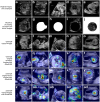Domain-guided data augmentation for deep learning on medical imaging
- PMID: 36952442
- PMCID: PMC10035842
- DOI: 10.1371/journal.pone.0282532
Domain-guided data augmentation for deep learning on medical imaging
Abstract
While domain-specific data augmentation can be useful in training neural networks for medical imaging tasks, such techniques have not been widely used to date. Our objective was to test whether domain-specific data augmentation is useful for medical imaging using a well-benchmarked task: view classification on fetal ultrasound FETAL-125 and OB-125 datasets. We found that using a context-preserving cut-paste strategy, we could create valid training data as measured by performance of the resulting trained model on the benchmark test dataset. When used in an online fashion, models trained on this hybrid data performed similarly to those trained using traditional data augmentation (FETAL-125 F-score 85.33 ± 0.24 vs 86.89 ± 0.60, p-value 0.014; OB-125 F-score 74.60 ± 0.11 vs 72.43 ± 0.62, p-value 0.004). Furthermore, the ability to perform augmentations during training time, as well as the ability to apply chosen augmentations equally across data classes, are important considerations in designing a bespoke data augmentation. Finally, we provide open-source code to facilitate running bespoke data augmentations in an online fashion. Taken together, this work expands the ability to design and apply domain-guided data augmentations for medical imaging tasks.
Copyright: © 2023 Athalye, Arnaout. This is an open access article distributed under the terms of the Creative Commons Attribution License, which permits unrestricted use, distribution, and reproduction in any medium, provided the original author and source are credited.
Conflict of interest statement
The authors have declared that no competing interests exist.
Figures


Similar articles
-
Targeted transfer learning to improve performance in small medical physics datasets.Med Phys. 2020 Dec;47(12):6246-6256. doi: 10.1002/mp.14507. Epub 2020 Oct 25. Med Phys. 2020. PMID: 33007112
-
Data augmentation using generative adversarial networks (CycleGAN) to improve generalizability in CT segmentation tasks.Sci Rep. 2019 Nov 15;9(1):16884. doi: 10.1038/s41598-019-52737-x. Sci Rep. 2019. PMID: 31729403 Free PMC article.
-
Improving Deep Learning-based Cardiac Abnormality Detection in 12-Lead ECG with Data Augmentation.Annu Int Conf IEEE Eng Med Biol Soc. 2022 Jul;2022:945-949. doi: 10.1109/EMBC48229.2022.9871969. Annu Int Conf IEEE Eng Med Biol Soc. 2022. PMID: 36086450
-
Ultrasound Signal Processing: From Models to Deep Learning.Ultrasound Med Biol. 2023 Mar;49(3):677-698. doi: 10.1016/j.ultrasmedbio.2022.11.003. Epub 2023 Jan 10. Ultrasound Med Biol. 2023. PMID: 36635192 Review.
-
Deep learning for electroencephalogram (EEG) classification tasks: a review.J Neural Eng. 2019 Jun;16(3):031001. doi: 10.1088/1741-2552/ab0ab5. Epub 2019 Feb 26. J Neural Eng. 2019. PMID: 30808014 Review.
Cited by
-
A YOLOv11-based AI system for keypoint detection of auricular acupuncture points in traditional Chinese medicine.Front Physiol. 2025 Jul 10;16:1629238. doi: 10.3389/fphys.2025.1629238. eCollection 2025. Front Physiol. 2025. PMID: 40708787 Free PMC article.
-
PixMed-Enhancer: An Efficient Approach for Medical Image Augmentation.Bioengineering (Basel). 2025 Feb 26;12(3):235. doi: 10.3390/bioengineering12030235. Bioengineering (Basel). 2025. PMID: 40150699 Free PMC article.
-
Development of an AI-Assisted System for Automatic Recognition and Localization Marking of Colonic Polyps (With Video).J Gastroenterol Hepatol. 2025 Jul;40(7):1797-1808. doi: 10.1111/jgh.16980. Epub 2025 Apr 14. J Gastroenterol Hepatol. 2025. PMID: 40229187 Free PMC article.
-
Deep Transfer Learning for Classification of Late Gadolinium Enhancement Cardiac MRI Images into Myocardial Infarction, Myocarditis, and Healthy Classes: Comparison with Subjective Visual Evaluation.Diagnostics (Basel). 2025 Jan 17;15(2):207. doi: 10.3390/diagnostics15020207. Diagnostics (Basel). 2025. PMID: 39857091 Free PMC article.
-
Machine Learning to Predict Outcomes of Fetal Cardiac Disease: A Pilot Study.Pediatr Cardiol. 2025 Apr;46(4):895-901. doi: 10.1007/s00246-024-03512-x. Epub 2024 May 9. Pediatr Cardiol. 2025. PMID: 38724761
References
-
- Buslaev A, Iglovikov VI, Khvedchenya E, Parinov A, Druzhinin M, Kalinin AA. Albumentations: Fast and Flexible Image Augmentations. Information. 2020. Feb;11(2):125.
Publication types
MeSH terms
Grants and funding
LinkOut - more resources
Full Text Sources
Miscellaneous

